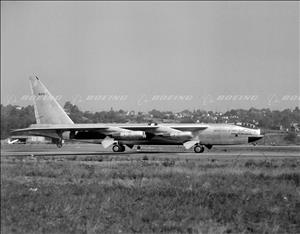On April 15, 1952, the huge YB-52 Stratofortress takes wing from Boeing Field. The plane surpasses anything then flying, with eight engines slung below swept wings measuring 185 feet from tip to tip. It is capable of carrying the largest nuclear devices available and one version is able to carry up to 30 tons of conventional weapons. The plane’s range initially is more than 5,000 miles and development of aerial refueling makes missions of up to 30 hours possible. Between 1954 and 1962, Boeing will manufacture more than 740 B-52s, first in Seattle and then Wichita, and scores of aircraft remain in active service.
The XB-52 Stratofortress prototype was rolled out in secret at Boeing Field on November 29, 1951. It did not fly until October 2, 1952. Thus the second prototype, the YB-52, was the first of this generation of aircraft to fly with its takeoff from Boeing Field on April 15, 1952.
The success -- or irony -- of the B-52 is that it never had to complete its primary mission: the dropping of a nuclear weapon in war. Rather, hundreds of aircraft remained aloft on rotating shifts to provide the Strategic Air Command with an assured means of retaliation in the event of a surprise nuclear attack by the Soviet Union or other power. The B-52, later augmented by intercontinental ballistic missiles and then by submarines capable of launching nuclear missiles, provided the first, sturdy leg of the three-pronged strategy of deterrence.
The B-52 saw combat in Vietnam, with several losses, delivering conventional bombs. It has also served as an important launch platform for experimental aircraft and spacecraft, including the X-15. Chiefly due to the failure of the North American B-1 swing-wing bomber to assume the B-52's key missions, the older but proven bomber (with many improvements and variants) remains on active duty as of 2008.
The YB-52 prototype, the Boeing B-52 Stratofortress, takes its first flight on April 15, 1952.
- By Walt Crowley
- Posted 9/14/2001
- HistoryLink.org Essay 3565
Sources:
Peter M. Bowers, Boeing Aircraft Since 1916 (London: Putnam, 1989); Boeing Historical Archives, Year by Year: 75 Years of Boeing History (Seattle: Boeing, 1991); Harold Mansfield, Vision: The Story of Boeing (New York, Popular Press, 1966); Robert Redding and Bill Yene, Boeing: Planemaker to the World (San Diego: Thunder Bay Press, 1997); Robert Serling, Legend & Legacy: The Story of Boeing and Its People (New York: St. Martin's Press, 1992); Boeing historical chronology, (www.boeing.com/companyoffices/history); Walter J. Boyne, "Fifty Years of the B-52," Air Force Magazine Online, accessed April 15, 2008 (http://www.afa.org/magazine/Dec2001/1201buff.asp); "B-52 Stratofortress History," GlobalSecurity.org, accessed April 15, 2008 (http://www.globalsecurity.org/wmd/systems/b-52-history.htm).
Note: This essay was corrected on April 15, 2008.
Licensing: This essay is licensed under a Creative Commons license that encourages reproduction with attribution. Credit should be given to both HistoryLink.org and to the author, and sources must be included with any reproduction. Click the icon for more info. Please note that this Creative Commons license applies to text only, and not to images. For more information regarding individual photos or images, please contact the source noted in the image credit.

